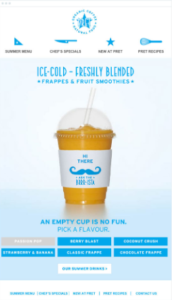The average person receives around 126 emails each day. With consumers’ inboxes becoming increasingly overcrowded, it can be difficult for brands to get noticed and stand out from the pack.
Consumers receive tons of messages every day, so they’ll only open and read the emails that interest them the most. If you want to get the attention of your audience, you might consider including interactive design elements in your emails.
What is an interactive email?
An interactive email is one that contains elements that subscribers can actively engage with by tapping (on mobile devices), clicking, or swiping on the element.
To better illustrate, here’s an email from international food chain Pret a Manger:

Source: Campaign Monitor
Advantages of interactive email
Interactive content has become a popular tool for digital marketers and is used in countless facets of marketing. However, one channel where interactive content can really shine is email marketing.
1. Interactive emails do wonders for engagement.
If your goal is to increase your engagement rates, then interactive emails are a surefire way to create meaningful engagement with your subscribers.
MarTech Advisor states that adding interactive content to your emails can increase your click-to-open rates by 73%. The company also suggests that adding videos to your emails can increase your click-to-open rates by 300%.
Simple yet effective interactive design elements include GIFs, sliders, and collapsing effects. These don’t take too much time or effort to create but still offer subscribers that feeling of engagement—something they won’t feel with a standard email.
If resources or manpower aren’t a problem, you can dive deeper into interactivity with email gamification.
Email gamification is a relatively new concept that involves applying elements and principles of gaming to provide subscribers with active engagement and to give them a sense of accomplishment.
Examples of email gamification include the use of puzzles, games, and point-scoring.

Source: Campaign Monitor
2. Consumers want interactive content.
In a survey by Zembula, respondents stated that interactive content was more engaging and enticing than static content. 69% of respondents said they preferred GIFs, 65% preferred watching videos, and a staggering 82% preferred interactivity in any form.
In the survey, respondents also stated that they preferred interactive content because they wanted to be informed, they wanted to feel curious, but most of all, they wanted to have fun. They prefer that brands provide them with interactive experiences.
In a separate survey by Demand Gen Report, 91% of respondents said they preferred consuming interactive content.
Behind the complexity of all these numbers lies one simple truth: consumers are looking for interactive content, and they will do business with the brands that provide that element.
So why not give your subscribers what they want?
3. Interactive emails drive conversion.
Increased email conversion rates are a natural byproduct of your increased engagement with subscribers.
This is because subscribers who are more engaged are also more likely to make purchases. In fact, according to a survey done by Rosetta Consulting, customers who were more engaged made purchases 90% more frequently and spent 300% more compared to unengaged customers. Engaged customers were also said to be more loyal to the same brand and purchase from them in the future.
Furthermore, according to Kapost, interactive content generates twice as many conversions as static content.
You can’t argue with hard facts. If you want to boost your conversions, you need to ramp up the interactivity of your emails.
Wrap Up
There’s one thing that’s abundantly clear. Interactive emails are the keys to getting your brand noticed in a crowded landscape and also boosting your revenue. Forget the days of sending standard emails with purely static elements. These types of messages are becoming things of the past, failing to offer your subscribers anything new.
In today’s digital age, interactive email marketing is the way to go.
If you’re not sure about how to design interactive elements for your emails and other web applications, an interaction designer might be able to help you out.
Author Bio
ADK guest blogger Ash Salleh is the Director of SEO at Campaign Monitor, where he works closely with content, copy, and analytics teams to improve site-wide optimization. Prior to his time at Campaign Monitor, he also provided SEO and digital marketing expertise at Zappos and Axiata Digital.
